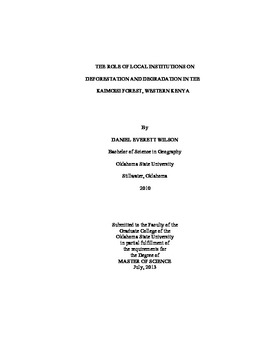| dc.description.abstract | The Kakamega Forest is the last remaining rainforest in Kenya and provides over 200,000 locals with important forest resources. This paper explores the role of local institutions (i.e. forest-use rules) on deforestation and degradation in the Kaimosi Forest, a smaller portion of the Kakamega Forest. Drawing from common property theory, this study examines various factors previously identified with successful management practices of common property forest resources. Additionally, this study draws from Cultural and Political Ecology (CAPE) perspectives to broaden the analysis of this people and forest relationship to include the role of household decision-making and power struggles among individual actors. The Kaimosi Forest is owned and managed by Kenyan Quaker Mission Church (QMC) that allows approximately 3,000 locals to use the forest while abiding by local institutions, or forest-use rules. Specifically, this paper looks at differing local perceptions with the QMC management, and how such rules influence forest-use and impact local livelihoods. The field methods include participant-observation techniques, 12 key-informant interviews, and 68 household surveys. The statistical methods for analyzing the household dataset include two-independent samples t-test and Pearson's correlations. The analysis compares a stratified sample of two villages surrounding the Kaimosi Forest. Variables include household level: demographics, land-use, livelihood, forest-use, and perception of local institutions. Results show that a revised management plan should be implemented by the QMC, and implemented in collaboration with local government leaders, the Kenyan Forest Service, and local residents in order to reduce pressures on forest resources. Furthermore, more forest commons studies are needed in the other parts of the Kakamega area to better understand why the smaller Kaimosi Forest fragment is undergoing the highest levels of deforestation and degradation. | |
